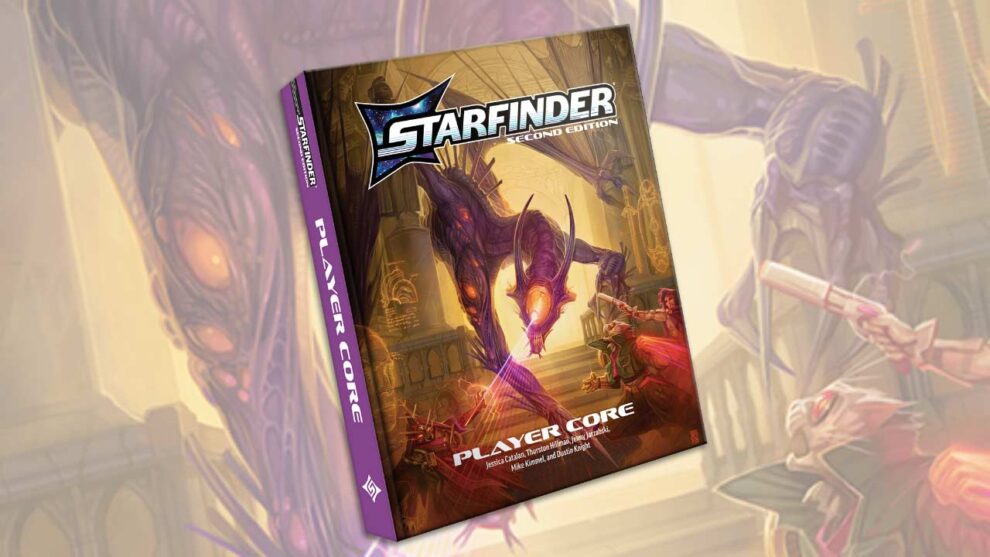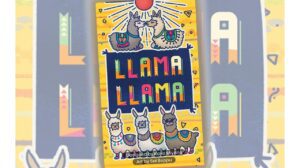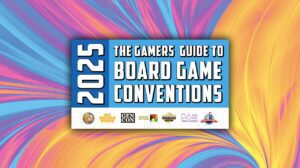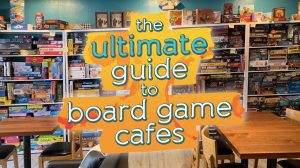Disclosure: Meeple Mountain received a free copy of this product in exchange for an honest, unbiased review. This review is not intended to be an endorsement.
Starfinder‘s initial release back in 2017 has endured its lumps. Qualms about the complexity and out-of-water feeling of the starship combat, multiple Armor Class values, and difficulty scaling issues with Skills are only a handful of the complaints that I’ve heard voiced over the years. Paizo responded by launching one of their most extensive playtests yet with the start of the Starfinder Second Edition Playtest last August. The resulting feedback and changes have culminated in the release of the Starfinder Player Core at Gen Con 2025. We received an early copy, so let’s go through some of the highlights.
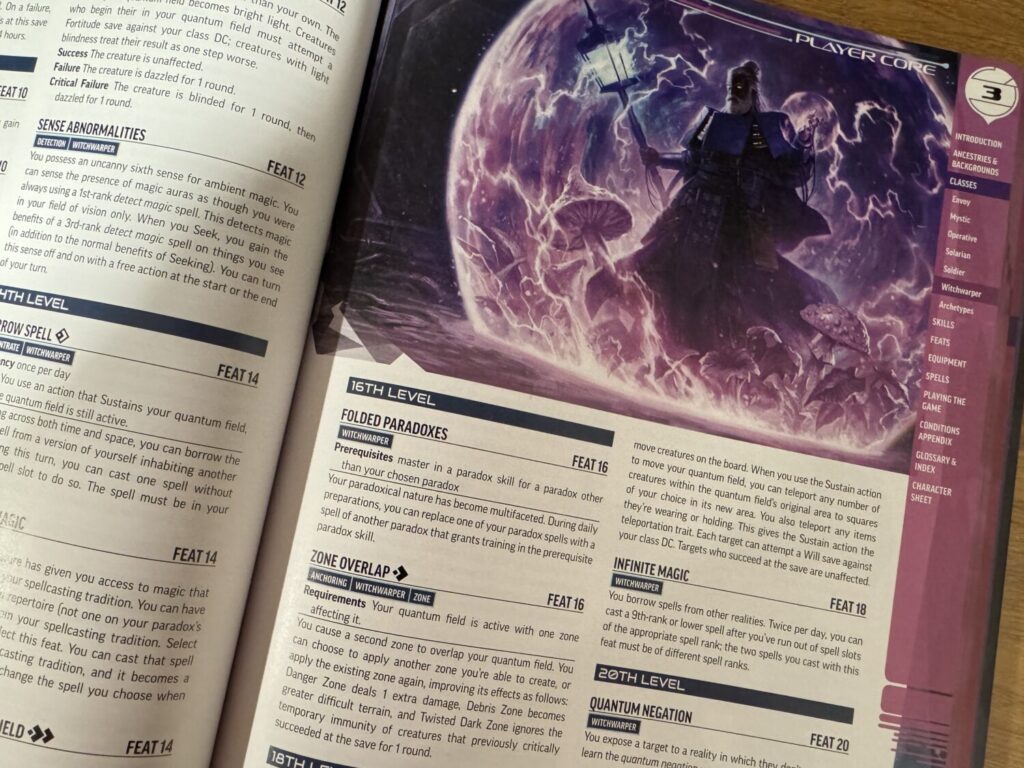
Starfinder Player Core
The main purpose of the Starfinder Player Core is to align the Starfinder Second Edition ruleset with the existing Pathfinder Second Edition ruleset, making them compatible systems. Bards wailing on electric keytars in zero G? Skittermanders rubbing elbows with goblins in an Alkenstar tavern? This release expands the playable options for both games, although the jury is still out on how much interplay there will be when adding aspects of one game into the other.
One of the first things players will notice upon opening the book is that the character creation process has been doubled from three pages to roughly seven pages. I distinctly remember my reaction to the three-page character creation spread for Starfinder First Edition, a notably compact set of steps. The increase in the Starfinder Player Core, however, doesn’t translate directly into complexity; Paizo has merely interspersed in the relevant information regarding Attributes, character sheet diagrams, and additional details to reduce page flipping to other book sections. It’s a very straightforward process designed to get characters from concept to table as quickly and efficiently as possible.
Thanks to the exceptional amount of Starfinder First Edition content to draw from, the Starfinder Player Core launches with a whopping 12 different Ancestry options, compared to 7 options in the original Core Rulebook. There’s a similar feeling across the board in the 455 pages that make up this book—there is a notable increase in the number of player options at launch in terms of Feats, Spells, and more.
The biggest exclusion in the Starfinder Player Core from its predecessor is that there are only six starting classes in the book. Woe to the Technomancer and Mechanic players who must find another class to play at launch, but only temporarily. A playtest wrapped up at the end of May for the Mechanic and Technomancer classes, which will be pushed in a future publication. The similarities between these two classes in how they deal with the advanced technology and machinery make them a suitable pair for a simultaneous release. They’ve been replaced by the Witchwarper, thereby giving players more options for magic-based classes from the jump.
Thanks to Pathfinder Second Edition alignment, EAC is gone! Energy Armor Class and Kinetic Armor Class are now baked into a solitary Armor Class score, thereby simplifying the rules and equipment with a single strike of red pen. Keeping track of two ACs and making sure that you’re using the correct value based on the damage source was unnecessary tedium that I’m happy to see revoked.
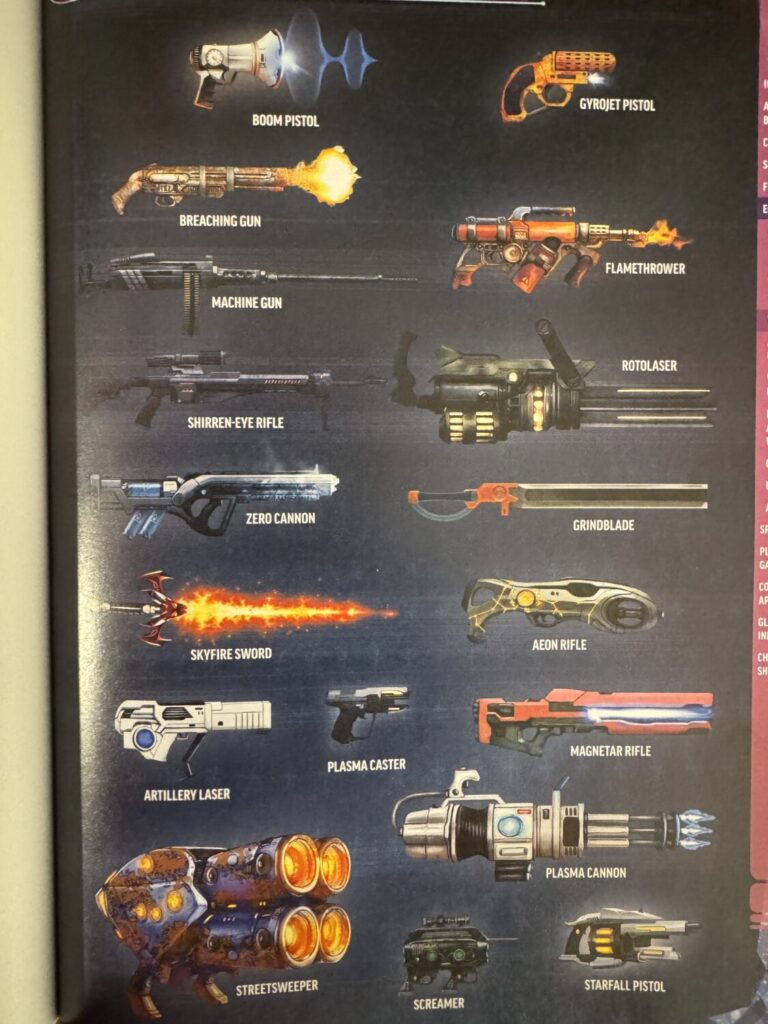
As far as equipment goes, the Starfinder Player Core is a vast upgrade over the original edition simply based on the presentation of things like weapons and armor. The Core Rulebook essentially only had tables of equipment with their relevant statistics followed by blurbs of descriptions several pages later. Now, the descriptions are upfront and there is consistency in the table structure outlining traits, reload actions, number of hands, and more. Grenades are also moved into their own equipment section—thankfully—so you no longer have to look at a table that repeats identical Range, Capacity, and Bulk entries for 30+ different grenades. It gives the equipment section a much cleaner, approachable design.
Another obvious omission in the book is that starship combat is completely removed! Having a sci-fi game addressing planetary exploration while lacking starship rules seems to be a big whiff, but they really needed a complete overhaul. Starship combat in First Edition felt like a separate game entirely, and more of a miniatures skirmish game where the player’s mechanical roles were shoehorned into roles in the starship. It was also more difficult to manage via a Theater of the Mind style of play, essentially requiring tracking on a board for all of the moving parts and tracking maneuvers. Despite the issues with the system, I have hope that starships will be back in a big way and hopefully more aligned with the core ruleset.
Navigation through the book is also exceptionally easier than it was in First Edition. Paizo introduced better margin detail with Pathfinder Second Edition, which expands to show the major headers as you progress through each section of the book. For example, flipping to the Equipment section shows the topics of Introduction, Tech Gear, Armor, Shields, Weapons, Armor Upgrades, Weapon Upgrades, Precious Ammunition & Weapons, Grenades, Magic Items, and Augmentations. It’s much preferable than skimming until you happen to stumble across the words ‘Tech Gear’. Combined with other quality of life enhancements like the Tag system for Traits, more concise block templates for statblocks, and better highlighting for types of mechanical text, the Starfinder Player Core is—dare I say—an enjoyable reference book to read.
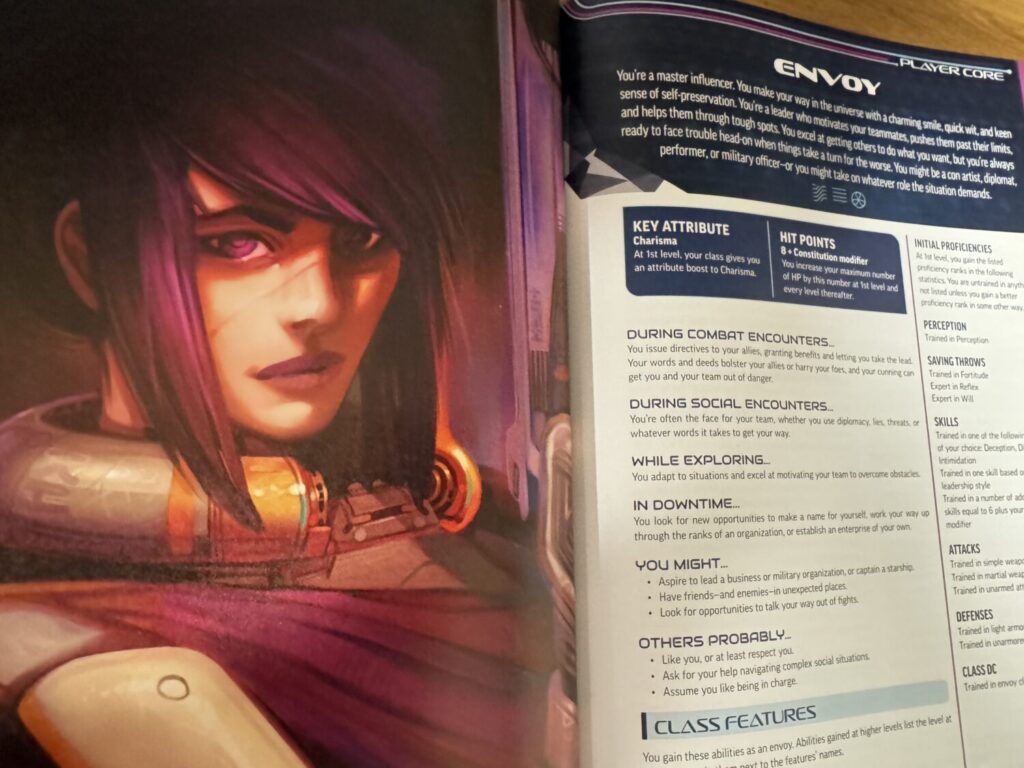
Starfinder Player Core: Notable Observations
There are a few other observations that I had while reviewing some of the class material. I’ll be transparent in saying that I didn’t participate in the Starfinder Playtest through the actual playing of the game, opting instead to follow along more casually with the conversations and content as it was released. I do not claim to be an expert at the system, and I’m certainly not an expert with a book that is still this shiny and new. These observations are merely notes that I found worthy of mentioning.
First up is the Envoy’s Get ‘Em Directive. In Starfinder Second Edition, the old Improvisations are now reclassified as Directives, and Get ‘Em has a fairly significant change. It has the same effect of spending an action to grant a +1 status bonus for you and your allies against a target until the beginning of your next turn. Now, however, it also can be used for two actions, granting you a Strike against that target as well, in turn granting you and your allies a +1 status bonus to damage on other Strikes made against it. You used to have to spend a Resolve point at 6th level to get this damage bonus, so the barrier to entry is much lower.
On the other hand, this means that to get the damage bonus, you have to perform a Strike. You generally aren’t going to be able to get that damage bonus through a Spell casting, as most of them require using two actions. It feels limiting to the role that you’d need to at least be proficient in a form of basic Strikes to fully take advantage of the initial, unique class ability. That being said, the Envoy does get another starting Directive, so they can pick up options to allow allies to get into better position, add off-guard conditions, or even swap arms as a reaction. Many of them still come with an extra benefit off Striking, but you can still do some interesting buffs and debuffs as an Envoy.
I also really appreciate that Witchwarpers have a choice between Charisma or Intelligence for their key attribute. It takes a class that has a lot of versatility and expands it to another degree. Your warper of reality can now spec appropriately based on your character concept, instead of being hemmed into a specific attribute. It’s the only class setup this way in the Starfinder Player Core.
Solarians were the class that initially grabbed my attention when First Edition was announced, with the ability to fill party holes as needed in terms of battlefield control, damage, or tank. During the Playtest, things soured a bit—their Class DC progression was quite poor and one of their signature class abilities, Solar Shot, keyed off Dexterity instead of Strength. Weird for a Strength-based class. Solar Shot has been renamed to Solar Flare and appropriately keys off Strength. Additionally, Solarians reach Expert at 9th level instead of 13th, and Master at 17th, so those are massive improvements. Also, revelations are gone! Black Hole and Supernova are now 4th level Feats, which again feels like some of the identity of the class has been stripped out, opting for players to make builds that center on one or the other.
Starfinder Combat Pad: Initiative Tracking Made Easy
On a related note to the Starfinder Player Core, Paizo released the new version of the Starfinder Combat Pad. This is a magnetic initiative tracker that comes with a variety of magnets for characters, NPCs, enemies, hazards, and conditions to help alleviate some of the mental burden for Gamemasters.
My preferred method of tracking initiative—if I’m not playing online through Foundry VTT—is to set up two columns on a page. The left column has the initiative value and combatant, while the right column tracks hit points and other important notes. If I want to remember an enemy’s special ability or need to slot in a condition, I use the spacing in those columns to facilitate that. It does wonders for helping me remember the things that I forget most. The Starfinder Combat Pad essentially fits this exact format, with the addition of adding a middle section for characters that are Delaying or have the Dying condition.
The top benefit that a magnetic pad gives you over simple pen and paper is shuffling characters around when they Delay. It is my number one pet peeve when I have to scribble over names, squeeze in the margins, and now all of my character-relevant notes are jumbled up. It’s a mess.
A magnetic pad doesn’t necessarily solve this problem entirely, but you can be creative with the spare magnets. I’ve started writing in the relevant notes on those blank magnets, so that I can move them in the initiative order along with the character as needed. No more running out of space, and only a mild amount of rewriting in hit points. An alternative to tracking HP alongside a character is to have an invisible third column on the far right, using the numbers on the magnets to keep track of enemy HP.
The design is slightly more functional than the combat pad for First Edition. This one comes with more magnets, more space for notes, and moves the duration tracker (for keeping tabs on round-based abilities) to the far right so that it’s not in the way. The new one also eliminates the Round Tracking, something which you can do on the duration track or just write in the corner. It really doesn’t need a dedicated spot. I did find that my marks didn’t wipe away cleanly (blue and green Expo markers, as shown below), so you may want some dry erase cleaner on hand.
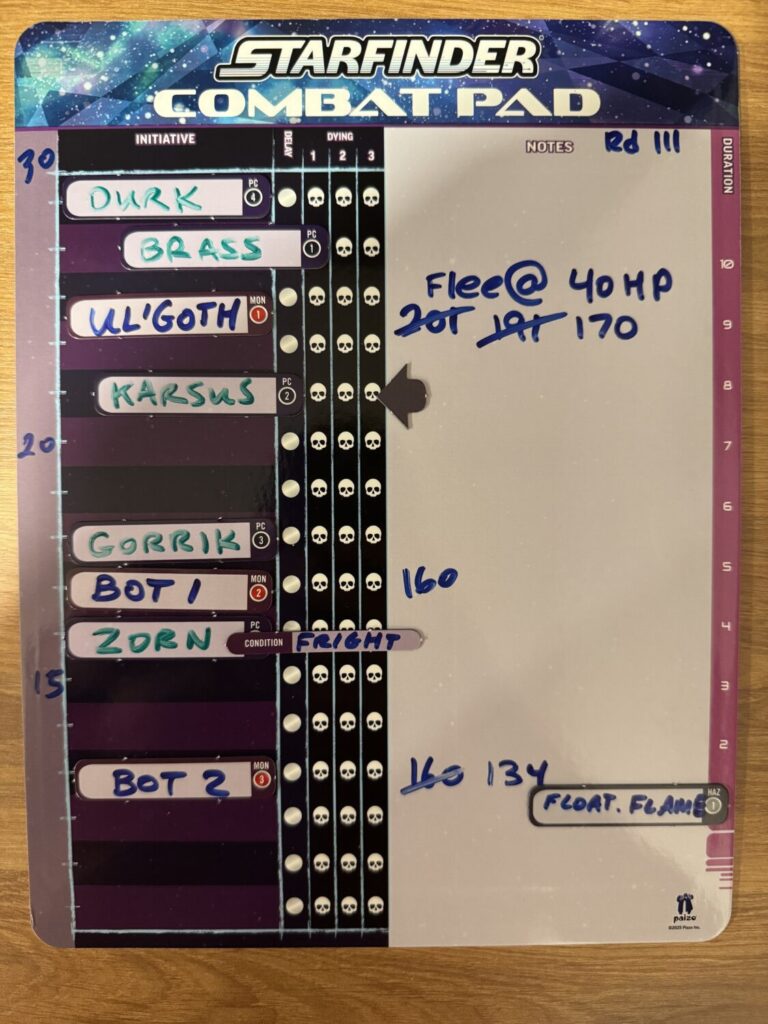
Starfinder Player Core: Shoot for the Moon
The hype for Starfinder Second Edition is real, and I’m excited to see the creative uses of how people combine it with Pathfinder Second Edition. One comment that I heard recently that really stuck with me was that Starfinder First Edition was a playtest for Pathfinder Second Edition. I’ve been thinking about that a lot lately, and it’s something that has come full circle with the Starfinder Player Core.
More Core material is on the horizon. The Starfinder GM Core is slated for release in late August, with the Starfinder Alien Core to follow in October. Together, these three tomes form the Starfinder Core, in a similar fashion to the Pathfinder Core series.
The stars are bright for Starfinder Second Edition and I’m ready for the ride.


